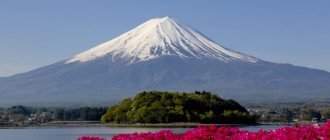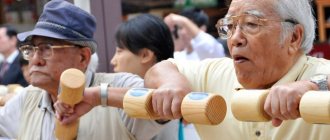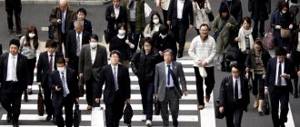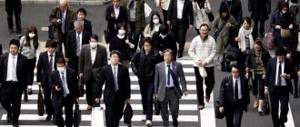Japanese - this is an incredible and open-to-the-world people, whose character has many distinctive features - hard work, discipline, practicality, accuracy. All this is intertwined with aesthetic features that are inherent in almost all Japanese, regardless of their location. After all, besides 127 million local population, more about 3 million Japanese live in the largest countries of the world. The largest number of representatives of the Asian country live in the United States (1.2 million people), as well as in Brazil (about 1.5 million people). About 120 thousand Japanese live in Asia, approximately 90 thousand live in Canada. About 15 thousand people live in European countries. A small number of Japanese (5 thousand people) can be seen in Australia, as well as in other countries of the planet.
Japanese people
Cultural characteristics of the Japanese people
Japanese culture is extremely rich and diverse. The Japanese express a heightened feeling in almost all areas of life, including cultural traditions. Despite the fact that each region has some differences in this area, family traditions are sacredly respected here, and they attach great importance to national holidays and various rituals. One of the main distinguishing features of the Japanese is their elevated attitude towards the world around them. Only the subtle spiritual organization of the inhabitants can so poetically glorify the forces of nature in their creativity. The Japanese have no less scrupulous attitude towards flowers, which is expressed by the development of various styles of flower arrangements - ikebana, rikka, nageire, seike. The tea ceremony, founded by Sen no Rikyu, occupies a special place among the Japanese. To learn this difficult custom requires quite a long time and endurance, which the Japanese do not have to spare. An important feature of the ceremony is not only the process of drinking tea, but also the aesthetic pleasure that guests receive during the entire process. The ancient ritual takes place in specially designated rooms and represents one of the most important and meaningful national traditions.
Peoples inhabiting Japan
During the formation of the Japanese state, most of the indigenous tribes of the archipelago were exterminated by the militant population of the country of Yamato, the ancestors of modern Japanese. Among the peoples that disappeared without a trace are the Kumaso, who inhabited the southern part of the archipelago, the Misihase from the northern coast of the Sea of Japan, and the Hayato from the island of Kyushu.
At the moment, there are three nationalities that still live on the archipelago - numerous Japanese (127 million on the archipelago and 3 outside it), Ryukyuans (1.3 million on the Ryukyu Islands and 300 thousand outside the state) and Ainu (25,000 in Japan and 109 in Russia).
Thus, the overwhelming majority (98%) of the modern population of the Japanese archipelago are, in fact, Japanese. The remaining nationalities (Ainu, Ryukyus) have a much smaller number of representatives.
Japanese spirituality
The Japanese people's calm attitude towards religiosity is due to the formation of several spiritual directions over the years. But still, Buddhism and Sentoism have the main influence on the way of life of the population. A large number of temples, both ancient and modern, impress with their majesty and originality. Despite the technological progress that has engulfed one of the oldest countries on the planet, people here take the observance of local rituals quite seriously. In addition to visiting Buddhist and Sento shrines, a third of the population periodically makes pilgrimages, which has a positive effect on the level of spirituality of the Japanese.
Features of national character
In addition to their adherence to national customs and love of nature, the Japanese can safely be called workaholics. This wonderful people is distinguished by a special responsibility and sense of duty, characterizing each resident as an example of a disciplined and efficient worker. In everyday life, the Japanese are characterized by such traits as politeness, goodwill, and respect for the older generation. The upbringing of children has an important influence on family relationships, which consists of teaching them to observe subordination in relation to the older generation. In this way, a sense of community and valued interests develops. First of all, this concerns a certain group, which is a prerequisite for the development of such qualities as a sense of duty and devotion to authority. In the daily life of the Japanese, friendliness and friendliness are self-evident concepts. Starting from a salesperson in a store, who will show maximum courtesy in service, to an expensive restaurant, where any client will be served with a smile, not because of high tips, but because politeness is an everyday norm among the Japanese. An equally important trait of the average Japanese is curiosity, characterized by a certain direction. This is partly due to the influence of Buddhist culture on the thinking of the population, which is distinguished by certain specifics.
Population of Japan. Unusual and interesting facts about the population of Japan
The Japanese are amazing people with an unusual worldview and a rich inner world. The population was unlucky with the geographical location of the country and sometimes unbearable natural conditions, but the difficulties only made them stronger and more resourceful. The Japanese people never tire of surprising the world with their colorfulness and a touch of madness. For a European, the Japanese will forever remain a mystery and mystery. You will never cease to be amazed at their oddities. Who are they, these inhabitants of the Land of the Rising Sun? Let's try to figure it out together.
National composition of the country
The majority of the population of Japan is a monocultural and homogeneous group of purebred Japanese. Only 1% of the state's residents (1.56 million) are representatives of the Korean diaspora and workers from Asia. As for Americans and Europeans, they live in Japan, but on a non-permanent basis.
A small part of the Ryukyus and Ainu aborigines live on the islands. There is also a separate community of Burakumin, which differs from Japanese society in cultural and everyday characteristics.
Residents communicate mainly in Japanese; they additionally study English in schools. It’s interesting that locals consider their native language to be very difficult, so they respect a foreigner who knows at least a little Japanese words.
Japan population size and density
The state ranks 7th in terms of population after China, India, Brazil, Indonesia, the USA and Russia. According to UN estimates, at the beginning of this year the population of Japan was more than 126.5 million people. Of these, 48.7% are male, 51.3% are female. More than 31 thousand are migrants. Over the past year, 1,269,374 people died, 1,050,211 were born. Statistics showed that the annual increase decreased by 0.12%. Over the past ten years, the population has remained virtually unchanged. The reason for this phenomenon is explained by the decline in the birth rate and low mortality of residents.
But thanks to immigrants, the number of people has increased slightly, although foreigners are not well received by locals due to lack of knowledge of Japanese culture and violation of current laws and regulations.
Japan is a fairly densely populated country. The average population density is 334 people/km2. But in the north of Hokkaido there are less than 70 people/km2, and in the coastal areas there are more than 500 people/km2.
The level of urbanization is impressive: 80% of residents live in cities. There are 655 large cities in Japan, 11 of which have a population of more than a million.
Most people are employed in the service sector, only 13% work in industry and 20% in the agricultural sector. Labor resources are characterized by a fairly high level of qualifications. The Japanese don’t know how to rest at all; they work on weekends and holidays, doing everything a lot and with high quality. I wonder: would such an approach to work be effective for the economies of European countries? It's a secret for now.
Difficult demographic situation
In the recent past, the natural increase in population was very high, but within a few years, as a result of political reforms aimed at reducing the birth rate, Japan's population declined sharply. Due to improved living conditions and a noticeable leap in the development of medicine, the mortality rate has dropped significantly. There are only three deaths per 1,000 newborns. This is a good indicator.
The average age of residents is 44.6 years. The average life expectancy for men is 77 years, for women – 85 years. Simply incredible numbers! But in the country there are only 13% of children and adolescents, 64% of people from 15 to 65 years old and 28% of old people. That is, the pension burden ratio is as much as 35.7%. The question arises: why do young families fail to fully reproduce themselves? At this rate, Japan's population is projected to decline to 97 million by 2050. It is unlikely that the Japanese authorities will allow such a situation. But with the current outlook on life, politicians are forced to work hard to stimulate population growth.
Taking a look at Japanese demographic changes, I would like to conclude that modern Japanese women often have no time to give birth. She needs more years of education, as a result of which she marries late. In addition, there are also financial obstacles, such as the high cost of raising children. Many young girls and boys have recently decided not to get married at all. And such a decision is followed by a refusal to bear children, since the Japanese do not welcome extramarital relationships.
Indeed, the working population preferred a career to marriage. In Japanese society, it is quite difficult to combine work and raising children. An interesting fact is that both sexes doubt family and marital values. 61% of unmarried men and 49.5% of unmarried women aged 18 to 35 did not have a sexual partner. Most didn't even want that. Perhaps, with this view, the population of Japan will not increase soon.
Local authorities are concerned about the state of demography in the country, because after some time, if everything develops at the current pace, the workforce will be greatly reduced.
Religious life of the Japanese
In Japan, there are different religious movements that have developed over many centuries. The main movements are Shintoism, Indian Buddhism and Christianity. Since the beginning of the 19th century, new Japanese sects have appeared on the basis of folk beliefs and rituals.
There are more than 200 thousand religious institutions and organizations in the country. The number of believers is statistically twice as large as the population of Japan. There is an explanation for this. Many residents of the Land of the Rising Sun are adherents of several religions, the existence of which precludes the slightest aggression towards humans. All beliefs are characterized by forbearance, love of neighbor, respect for family and ancestors, respect for nature, close interaction between man and God, purification, and the unity of religious rituals with everyday life.
Secrets of Japanese longevity
The Japanese population owes its high life expectancy to a healthy diet and a developed healthcare system.
The Japanese menu includes grains, soy and seafood. For breakfast, lunch and dinner, the main ingredient is, of course, rice. And its combination with fish wrapped in seaweed is a delicacy known throughout the world called sushi.
Fruits in the Land of the Rising Sun are very expensive: for two dollars you can buy just one apple or apricot. But, nevertheless, they are eaten in larger quantities and exclusively fresh.
Also, Japanese people love greens and vegetables, especially eggplant, spinach, bamboo shoots, and broccoli. They eat food only in season.
It may seem that the variety of food in Japan is very poor, but in a week a Japanese family eats about 50 different dishes, while a European family eats only 30.
The Japanese, in addition to everything said above, move a lot and do physical exercises. Naturally, the result was not long in coming. Only three out of a hundred people in Japan are overweight. For comparison: in America, as much as 34% of the population suffers from this disease.
This is the whole secret of the longevity of the Japanese. By following these principles, we can boast of good health.
Unusual Japanese traditions
The population of Japan observes a huge number of traditions and rituals. The life of the Japanese is literally permeated with a network of customs and ceremonies, this is especially visible in communication between people.
The Japanese do not greet with a handshake, but with a slight bow, the depth and duration of which should correspond to the social status of the person they meet. When talking, residents of the Land of the Rising Sun begin their speech with an apology, as if for wasting the interlocutor’s time. And they always smile.
The Japanese always take a bath before going out; in general, they are obsessed with personal hygiene. They even wear special slippers to the toilet so as not to spread dirt around the house.
Even in Japan there is a cult of food. They can talk about food for hours, while smacking their lips deliciously. It is considered ignorant not to tell the hostess “It’s very tasty.” And the best souvenir, perhaps, will be a new tasty treat.
Interestingly, for the Japanese, tipping is perceived as an obscene gesture. After all, by paying the set price for the service, the visitor remains on an equal footing with the workers of the establishment. Otherwise, he will show his superiority, which amounts to an insult.
It is unacceptable to enter the house with shoes on. There is a special place for street shoes, where stepping on your toe is tantamount to disaster - because it’s dirty there.
In general, Japan is a country of naive, sympathetic and very smart people. Many of their actions on the part of the Europeans defy common understanding, but thanks to such actions, the population of Japan will always maintain great interest in themselves.
The Japanese are quite sociable, but you also need to be able to carry on a conversation competently. To do this, take our basic course “Japanese for Beginners in Three Steps” and speak Japanese!
What interesting or funny facts do you know about the Japanese? Perhaps you have noticed something in your communication with the residents of the Land of the Rising Sun? Please share.











